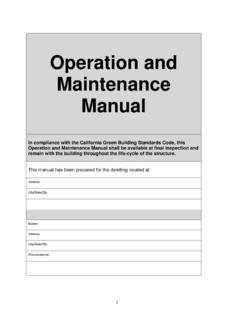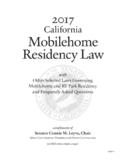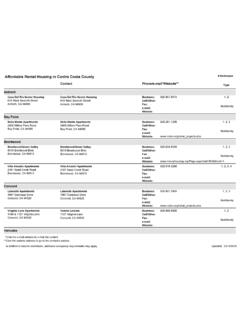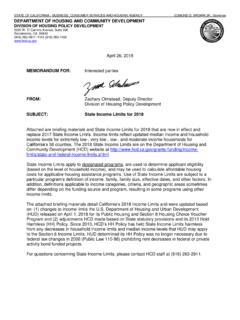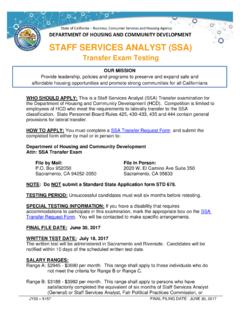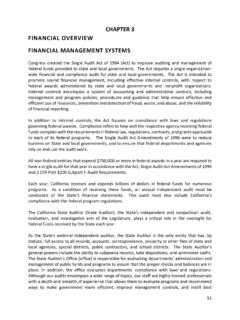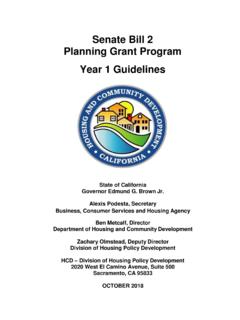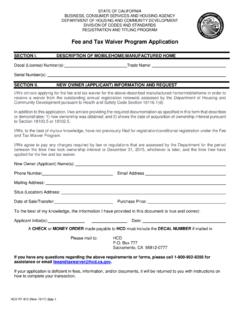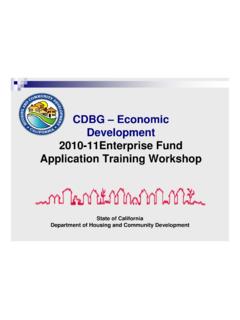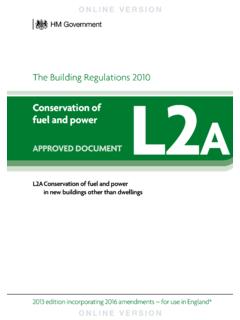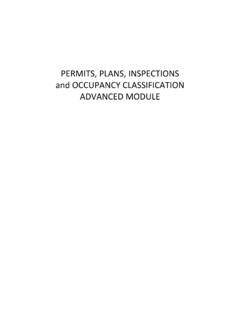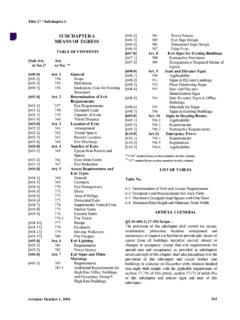Transcription of CHAPTER 7A [SFM] MATERIALS AND CONSTRUCTION …
1 11 .. Color profile: Generic CMYK printer profile Composite Default screen CHAPTER 7A [SFM] MATERIALS AND CONSTRUCTION METHODS FOR EXTERIOR WILDFIRE EXPOSURE > > > SECTION 701A SCOPE, PURPOSE AND APPLICATION Scope. This CHAPTER applies to building MATERIALS , sys-tems and/or assemblies used in the exterior design and con-struction of new buildings located within a Wildland-Urban Interface Fire Area as defined in Section 702A. Purpose. The purpose of this CHAPTER is to establish minimum standards for the protection of life and property by increasing the ability of a building located in any Fire Hazard Severity Zone within State Responsibility Areas or any Wildland-Urban Interface Fire Area to resist the intrusion of flames or burning embers projected by a vegetation fire and contributes to a systematic reduction in conflagration losses.
2 Application. New buildings located in any Fire Hazard Severity Zone or any Wildland-Urban Interface Fire Area des-ignated by the enforcing agency constructed after the applica-tion date shall comply with the provisions of this CHAPTER . Exceptions: 1. Buildings of an accessory character classified as a Group U occupancy and not exceeding 120 square feet in floor area, when located at least 30 feet from an applicable building . 2. Buildings of an accessory character classified as Group U occupancy of any size located least 50 feet from an applicable building . 3. Buildings classified as a Group U Agricultural Build-ing, as defined in Section 202 of this code (see also Appendix C Group U Agricultural Buildings), when located at least 50 feet from an applicable building .
3 4. Additions to and remodels of buildings originally constructed prior to the applicable application date. Application date and where required. New build-ings for which an application for a building permit is sub-mitted on or after July 1, 2008 located in any Fire Hazard Severity Zone or Wildland Interface Fire Area shall comply with all sections of this CHAPTER , including all of the follow-ing areas: 1. All unincorporated lands designated by the State Board of Forestry and Fire Protection as State Responsibility Area (SRA) including: Moderate Fire Hazard Severity Zones High Fire Hazard Severity Zones Very-High Fire Hazard Severity Zones 2.
4 Land designated as Very-High Fire Hazard Severity Zone by cities and other local agencies. 3. Land designated as Wildland Interface Fire Area by cities and other local agencies. Exceptions: 1. New buildings located in any Fire Hazard Severity Zone within State Responsibility Areas, for which an application for a build-ing permit is submitted on or after January 1, 2008, shall comply with all sections of this CHAPTER . 2. New buildings located in any Fire Hazard Severity Zone within State Responsibility Areas or any Wildland Interface Fire Area designated by cities and other local agen-cies for which an application for a building permit is submitted on or after December 1, 2005 but prior to July 1, 2008, shall only comply with the following sections of this CHAPTER : Section 705A Roofing Section 706A Attic Ventilation Inspection and certification.
5 building permit applica-tions and final completion approvals for buildings within the scope and application of this CHAPTER shall comply with the fol-lowing: 1. building permit issuance. The local building official shall, prior to CONSTRUCTION , provide the owner or appli-cant a certification that the building as proposed to be built complies with all applicable state and local build-ing standards, including those for MATERIALS and con-struction methods for wildfire exposure as described in this CHAPTER . Issuance of a building permit by the local building official for the proposed building shall be con-sidered as complying with this section.
6 2. building permit final. The local building official shall, upon completion of CONSTRUCTION , provide the owner or applicant with a copy of the final inspection report that demonstrates the building was constructed in compli-ance with all applicable state and local building stan-dards, including those for MATERIALS and CONSTRUCTION methods for wildfire exposure as described in this chap-ter. Issuance of a certificate of occupancy by the local building official for the proposed building shall be con-sidered as complying with this section. Vegetation management compliance. Prior to build-ing permit final approval, the property shall be in compliance with the vegetation management requirements prescribed in California Fire Code Section 4906, including California Pub-lic Resources Code 4291 or California Government Code Sec-> 2010 CALIFORNIA building CODE 255 3 M:\data\CODES\STATE CODES\California\2010\Part 2_Building\Final VP\Volume 1 of 2\ Friday, June 18, 2010 9:13:34 AM.
7 11 11 11 .. Color profile: Generic CMYK printer profile Composite Default screen MATERIALS AND CONSTRUCTION METHODS FOR EXTERIOR WILDFIRE EXPOSURE tion 51182. Acceptable methods of compliance inspection and documentation shall be determined by the enforcing agency and may include any of the following: 1. Local, state or federal fire authority or designee autho-rized to enforce vegetation management requirements 2. Enforcing agency 3. Third party inspection and certification authorized to enforce vegetation management requirements 4. Property owner certification authorized by the enforcing agency SECTION 702A DEFINITIONS For the purposes of this CHAPTER , certain terms are defined below: CDF DIRECTOR means the Director of the California Department of Forestry and Fire Protection.
8 EXTERIOR COVERING. The exposed siding or cladding material applied to the exterior side of an exterior wall, roof eave soffit, floor projection or exposed underfloor framing. FIRE PROTECTION PLAN is a document prepared for a specific project or development proposed for a Wildland Urban Interface Fire Area. It describes ways to minimize and mitigate potential for loss from wildfire exposure. The Fire Protection Plan shall be in accordance with this CHAPTER and the California Fire Code, CHAPTER 49. When required by the enforcing agency for the purposes of granting modifications, a fire protection plan shall be submitted.
9 Only locally adopted ordinances that have been filed with the Cali-fornia building Standards Commission or the Department of Housing and Community Development in accordance with Section shall apply. FIRE HAZARD SEVERITY ZONES are geographical areas designated pursuant to California Public Resources Codes Sections 4201 through 4204 and classified as Very High, High, or Moderate in State Responsibility Areas or as Local Agency Very High Fire Hazard Severity Zones designated pursuant to California Government Code, Sections 51175 through 51189. See California Fire Code Article 86. The California Code of Regulations, Title 14, Section 1280, entitles the maps of these geographical areas as Maps of the Fire Hazard Severity Zones in the State Responsibility Area of California.
10 HEAVY TIMBER. A type of CONSTRUCTION classification speci-fied in Section 602. For use in this CHAPTER , heavy timber shall be sawn lumber or glue laminated wood with the smallest mini-mum nominal dimension of 4 inches (102 mm). Heavy timber walls or floors shall be sawn or glue-laminated planks splined, tongue-and-grove, or set close together and well spiked. IGNITION-RESISTANT MATERIAL. A type of building material that resists ignition or sustained flaming combustion sufficiently so as to reduce losses from wildland-urban inter-face conflagrations under worst-case weather and fuel condi-tions with wildfire exposure of burning embers and small flames, as prescribed in Section 703A and SFM Standard 12-7A-5, Ignition-Resistant Material.
